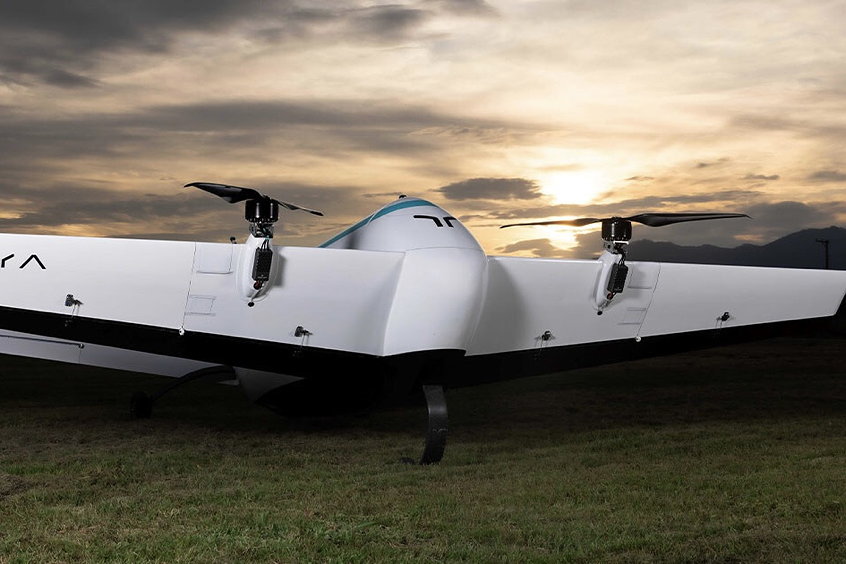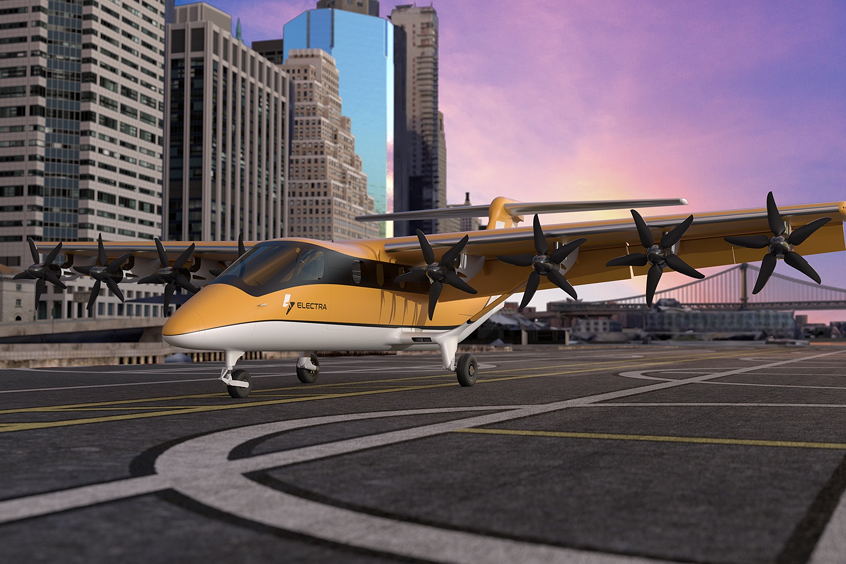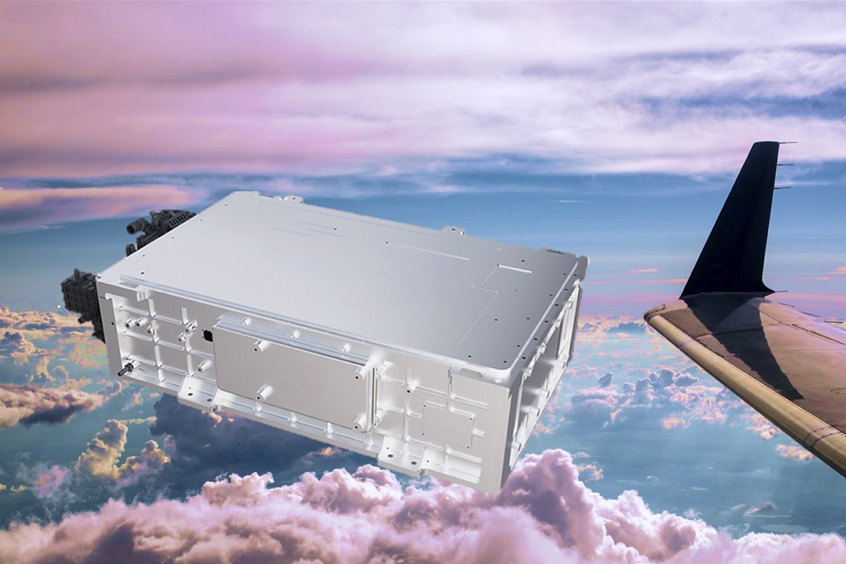Heart Aerospace, the Swedish hybrid-electric aircraft maker, has filed two EU design applications and one patent application for an innovative new nacelle integration design that significantly improves the flight characteristics of its regional hybrid-electric aircraft, the ES-30, allowing it to operate on shorter runways.
In contrast to the most widespread designs, that locate the nacelle under the wing, Heart’s solution is centred on the wing and designed for a vortex generation at a high angle of attack (the angle between the wing and the oncoming airflow), preventing the nacelle from significantly deteriorating the wing's performance.
“This innovation reflects Heart’s strategy to simultaneously develop both the aircraft’s design and the production process, ensuring rapid innovation and ability to adapt to changes,” says Anders Forslund, co-founder and CEO of Heart Aerospace.
Heart has also revealed its first full-scale aircraft demonstrator, the Heart Experimental 1 (Heart X1), which signifies the company’s creation of a flexible manufacturing process that is repeatable, automated, and uses automatic inspection.
“Our new nacelle integration design will be manufactured inhouse, using automated composite technology, and incorporated on Heart’s upcoming airplane prototype, the Heart X2,” says Ben Stabler, Chief Technology Officer at Heart Aerospace.
The interaction between a wing and a nacelle plays a crucial role in determining an aircraft’s aerodynamic performance. At high angles of attack, traditional nacelle designs can cause airflow separation, leading to stall and a rapid loss of lift. Heart’s design minimizes the aerodynamic interference between the nacelle and wing, allowing for a higher angle of attack and delaying stall. This improves lift generation during both cruise and landing phases, giving the ES-30 the ability to fly at lower speeds with greater aerodynamic efficiency.
Built almost entirely in-house at Heart's Gothenburg facilities, the demonstrator reflects the company's strategy to simultaneously develop both the design and production processes.
"Our industry is approaching a 30-year innovation cycle, and we have less than 25 years to decarbonize aviation. We need to develop new methods to get net zero aerospace technologies to market faster," says Anders Forslund, co-founder and CEO of Heart Aerospace. "It is a testament to the ingenuity and dedication of our team that we're able to roll out a 30-seat aircraft demonstrator with a brand-new propulsion system, largely inhouse, in less than two years. "
With a commanding 32 metre wingspan, the demonstrator, named Heart Experimental 1 (Heart X1), will serve as a platform for rigorous testing and development of Heart's ES-30 aircraft.
Initially, the HX-1 will be used for ground-based testing, focusing on charging operations, taxiing, and turnaround procedures. It is scheduled to undertake a fully electric first flight in the second quarter of 2025. In preparation for this flight, Heart will over the coming months, test critical systems by running hardware tests both on and off the airplane.
Development of the Heart X1 has been funded in part by grants provided by the Swedish Innovation Agency, Vinnova, highlighting the essential collaboration between government and industry that is needed to bring new aviation technologies to market.
"Developing innovative net-zero propulsion aerospace technologies demands a revolution in product development and manufacturing, much like what we've witnessed in the automotive and space industries," said Ben Stabler, Chief Technology Officer at Heart Aerospace.
Building on the experience of developing the Heart X1, Heart is now focused on creating a state-of-the-art aircraft manufacturing process that leans into the latest technologies in composite manufacturing and product lifecycle management, building a data-driven assembly line with high repeatability, automation and non-destructive inspection.
Heart's next step in developing the ES-30 is the building of a pre-production prototype, the Heart X2, which will further mature the design and production methods based on lessons learned from the Heart X1.
The Heart X2 is scheduled for a hybrid flight in 2026 and will demonstrate the company's Independent Hybrid propulsion system. In August, Heart Aerospace was selected for a $4.1 million grant by the Federal Aviation Administration's (FAA) Fuelling Aviation's Sustainable Transition (FAST) program to develop the management system for the hybrid-electric propulsion.
This momentum will continue with the establishment of a pilot manufacturing plant to accelerate prototyping toward the manufacturing of a fully conforming aircraft, with Heart targeting type certification of the ES-30 by the end of the decade.
Heart has been collaborating with airlines Braathens Regional Airlines and SAS, and airport operator Swedavia to complete ground support procedure tests for electric aircraft.
The tests were conducted as part of the Swedish research project ELISE, which brings together technology companies with airlines and airports to foster the development of electric aviation infrastructure in Sweden. This phase of the ELISE project focused on creating a full-scale demonstrator of Heart’s regional ES-30 airplane for the testing of ground handling procedures.
“Commercial customers are eager to reduce operational costs and decarbonize their fleets, but they face a set of complex challenges, such as which plug standard to install and how to bring megawatts of power to remote facilities. We are working closely with industry advisors through the ELISE project to ensure we meet these specific needs. By collaborating with experts, we aim to create an infrastructure tailored for electric aircraft and the airport,” says Simon Reinberth, Airport Infrastructure Manager at Heart Aerospace.
Funded by the Swedish innovation agency Vinnova, the third step of the ELISE project is driving rapid technological advancement and innovation, crucial for reducing the environmental and climate impact of aviation.
“As one of the leaders in the aviation industry's move toward lower greenhouse gas emissions, we believe that partnerships like the Elise program are key to speeding up the development of the advanced technologies required to meet the industry's net-zero targets. By collaborating with like-minded stakeholders who share their knowledge and expertise, sharing the results with the rest of the industry, we are confident that our commitment will play a significant role in bringing hybrid-electric and fully electric aircraft technologies to market more quickly," says Lars Resare, Chief Sustainability Officer at Braathens Regional Airlines.
“SAS is playing a key role in driving the aviation industry´s transformation. We believe collaboration is key to unlocking innovative solutions and through the ELISE program, SAS is gaining valuable insights into electric aviation. This keeps us stay ahead of market trends and helps us shape the future of electric aircraft. This initiative also allows us to involve our employees and customers, increasing awareness of the latest aircraft technologies”, says Ann-Sofie Hörlin, Head of Sustainability at SAS.
The ground support procedures tested at Säve Airport in Gothenburg included:
- Verification and Testing of the Charging Procedure: Ensuring the reliability and efficiency of the electric aircraft charging process.
- Evaluation of Charging Routines: Optimizing charging routines to enhance operational efficiency.
- Onboarding and Offboarding Procedures: Streamlining the processes for passengers and cargo specifically for electric aircraft.
- Ground Support Experience and Maintenance Routines: Training ground support personnel to ensure seamless operations.
“It is very gratifying that Swedavia through the ELISE project can contribute with our broad collective knowledge and competence regarding battery-powered electric aviation and its infrastructural and operational consequences on airports. Electric aircraft could play an important role for regional flights and thus provide more accessibility in our sparsely populated country. As a world leader in operating airports with the least possible environmental impact, we continue to be an active partner in aviation's necessary climate change transition by developing and enabling the future of fossil free aviation, from battery electric aircrafts to hydrogen aircrafts, and of the use of SAF in aviation”, says John Nilsson, senior strategist responsible for electric and hydrogen aircraft at Swedavia.
Sweden has a strong aviation industry and a transport infrastructure that depends on air travel and the successful completion of these ground testing procedures brings the vision of eco-friendly air travel in the country closer to reality.
This milestone reflects the hard work and dedication of the entire ELISE consortium which also includes Swedish battery manufacturer Northvolt, and an advisory board consisting of Sweden's Regional Airports (SRF), Research Institutes of Sweden (RISE), Bromma Air Maintenance (BAM), Swedish Civil Aviation Administration (LFV), Swedish Transport Agency (TS), and Swedish Transport Administration (TrV).
| Contact details from our directory: | |
| Heart Aerospace | Airframer |
| Northvolt | Electric Batteries |
| Related aircraft programs: |
| Heart ES-30 |
| Related directory sectors: |
| Electrical Power Systems |
Weekly news by email:
See the latest Bulletin, and sign up free‑of‑charge for future editions.

Altair collaborates with aerospace startup Moya Aero to develop eVTOLs

Electra reveals design for EL9 hybrid-electric aircraft
Piper Aircraft achieves AS9100 certification
